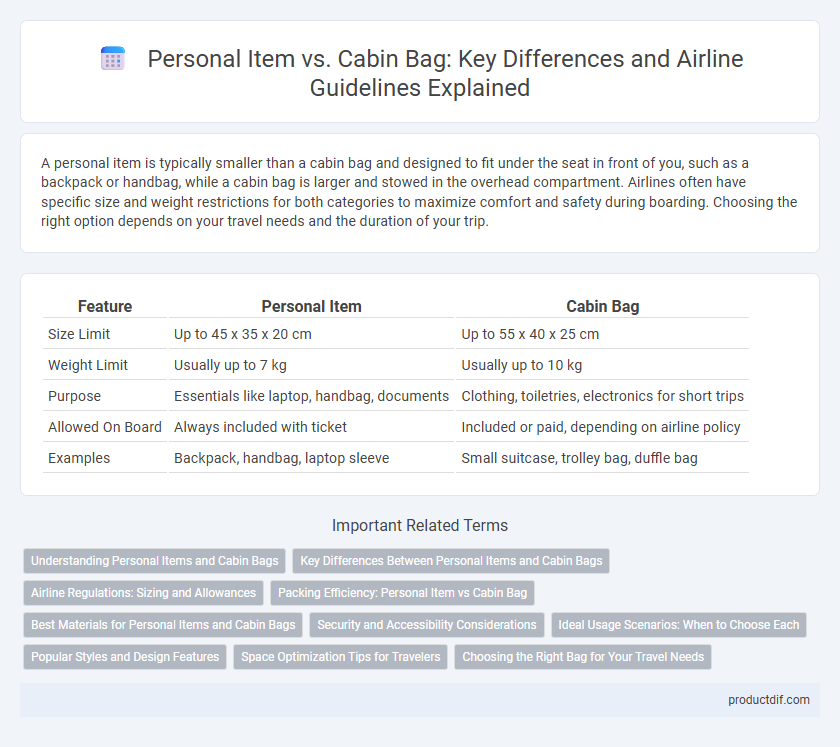A personal item is typically smaller than a cabin bag and designed to fit under the seat in front of you, such as a backpack or handbag, while a cabin bag is larger and stowed in the overhead compartment. Airlines often have specific size and weight restrictions for both categories to maximize comfort and safety during boarding. Choosing the right option depends on your travel needs and the duration of your trip.
Table of Comparison
| Feature | Personal Item | Cabin Bag |
|---|---|---|
| Size Limit | Up to 45 x 35 x 20 cm | Up to 55 x 40 x 25 cm |
| Weight Limit | Usually up to 7 kg | Usually up to 10 kg |
| Purpose | Essentials like laptop, handbag, documents | Clothing, toiletries, electronics for short trips |
| Allowed On Board | Always included with ticket | Included or paid, depending on airline policy |
| Examples | Backpack, handbag, laptop sleeve | Small suitcase, trolley bag, duffle bag |
Understanding Personal Items and Cabin Bags
Personal items are compact belongings such as handbags, laptop bags, or small backpacks that fit under the airplane seat, typically measuring around 18 x 14 x 8 inches. Cabin bags, also known as carry-on luggage, are larger but still meet airline size restrictions, usually not exceeding 22 x 14 x 9 inches, and are stored in overhead compartments. Understanding the size limits and allowed contents for both personal items and cabin bags ensures compliance with airline policies and smooth security checks.
Key Differences Between Personal Items and Cabin Bags
Personal items typically include smaller belongings like handbags, laptop bags, or backpacks that fit under the airplane seat, while cabin bags refer to larger carry-on suitcases or duffel bags that occupy overhead bin space. Airlines impose stricter size and weight limits on personal items, generally allowing dimensions around 18 x 14 x 8 inches, compared to cabin bags which often measure up to 22 x 14 x 9 inches. Understanding these distinctions ensures compliance with airline policies and maximizes packing efficiency during travel.
Airline Regulations: Sizing and Allowances
Airline regulations typically differentiate personal items from cabin bags based on size and weight allowances, with personal items usually restricted to dimensions around 40 x 30 x 15 cm and weight limits near 7 kg, whereas cabin bags can measure up to 55 x 40 x 20 cm with weight allowances reaching 10-12 kg. These size constraints ensure compliance with overhead bin capacity and under-seat storage requirements, varying slightly across major airlines such as American Airlines, British Airways, and Emirates. Passengers must verify specific carrier policies before travel to avoid fees or gate check procedures for non-compliant luggage.
Packing Efficiency: Personal Item vs Cabin Bag
A personal item typically offers more efficient packing for essential belongings due to its compact size and easy access under the seat, maximizing space without exceeding airline limits. Cabin bags, while larger and able to carry more, demand strategic organization to fully utilize interior compartments and avoid wasted space. Choosing between a personal item and cabin bag hinges on balancing packing capacity with convenience and compliance with airline regulations.
Best Materials for Personal Items and Cabin Bags
Premium personal items and cabin bags are crafted from durable materials such as ballistic nylon, polycarbonate, and high-grade leather, offering excellent resistance to wear and tear. Ballistic nylon provides exceptional strength and water resistance, making it ideal for frequent travelers requiring lightweight yet robust protection. Polycarbonate shells ensure impact resistance for cabin bags, while leather adds a luxurious finish combined with durability for personal items.
Security and Accessibility Considerations
Personal items offer enhanced security by fitting under the seat, allowing constant visibility and quick access to valuables, reducing the risk of theft. Cabin bags, while larger and storable in overhead compartments, may require passengers to leave their seats, increasing the chance of unattended luggage. Prioritizing a compact personal item ensures both secure handling and immediate accessibility during travel.
Ideal Usage Scenarios: When to Choose Each
Personal items, such as backpacks or small tote bags, are ideal for carrying essentials like passports, wallets, and electronics during short flights or when you need quick access to your belongings on board. Cabin bags, typically larger and meeting airline carry-on size restrictions, suit travelers who want to pack clothing and toiletries for overnight trips or short business travel without checked baggage. Choosing between personal item and cabin bag depends on travel duration, packing needs, and airline policies regarding carry-on size limits.
Popular Styles and Design Features
Personal items typically include compact backpacks, tote bags, and slim briefcases designed for convenience and ease of access, featuring multiple compartments and lightweight materials. Cabin bags often showcase rolling suitcases and duffel bags with expandable compartments, reinforced handles, and durable, water-resistant fabrics to withstand frequent travel. Popular design features across both categories emphasize organizational pockets, ergonomic straps, and sleek, modern aesthetics to enhance portability and style.
Space Optimization Tips for Travelers
Maximizing space in your personal item involves using compression packing cubes that reduce bulk and organize belongings efficiently, allowing more items to fit neatly. Choosing lightweight, expandable cabin bags with multiple compartments helps separate essentials and ensures easy access during travel. Rolling clothes instead of folding them saves space and minimizes wrinkles, making the most of limited luggage dimensions allowed by airlines.
Choosing the Right Bag for Your Travel Needs
Selecting the right luggage depends on airline regulations and the duration of your trip, where a personal item typically fits under the seat and is ideal for essentials, while a cabin bag offers more space and fits in overhead compartments. Dimensions and weight limits vary by airline, so verifying these before packing ensures a hassle-free boarding experience. Prioritize your packing needs and travel style to decide between the compact convenience of a personal item or the increased capacity of a cabin bag.
Personal Item vs Cabin Bag Infographic

 productdif.com
productdif.com